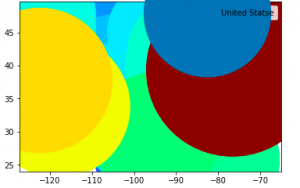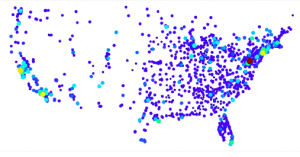Final Report Draft (Only the Abstract to go)
Update on Final Report
4.10 Update (A Further Look into Hospitals that Overcharge for Services)
On Monday I said that this week’s focus would be to look at specific hospitals that are charging over $20,000 through Medicare for an intracranial hemorrhage and note any charging policies or factors that are going into the absurd pricing. However, after looking at just 2 of the highest priced hospitals it was clear that something very wrong was going on. My notes from the hospitals are as follows:
- Of the 50 hospitals with the highest price markups, 49 are for-profit hospitals and 46 are owned by for-profit health systems.
- Johns Hopkins Health Center – Advantage MD (Highest Cost at $48,632.28)
- John Hopkins created a “Medicare Advantage plan that is offered by private companies that contract with the Centers for Medicare and Medicaid Services to provide both Medicare Part A (hospital insurance) and Medicare Part B (medical insurance)”
- 11% of the eligible population is enrolled in a Medicare Advantage plan (national is 34%). Approximately 900,000 Marylanders are eligible for Medicare
- ******”The hospital pursued the suits even though they collected millions of dollars from other patients, in the form of higher rates for hospital services, to cover costs for low-income patients who lacked insurance or enough insurance to cover out-of-pocket expenses”
- San Francisco General Hospital (Second Highest Cost at $34,455.00)
- Out-of-network with all private insurance
- “Emergency room fees are also higher, on average, than ERs nationally, in the state of California, and in the city of San Francisco. In the city, they’ve charged up to five times as much. The fees are set by the San Francisco Boards of Supervisors, which has voted for steady increases, doubling the charge since 2010”
- “Facility fees” – “Nina Dang, a 24 year-old woman treated at the hospital after a bike crash, was billed $11,176 for her emergency room visit. The largest item on her bill was a $24,074.50 emergency room facility fee”
- Billed $9.20 for a single ibuprofen tablet in 2013
The biggest takeaway I found was the idea of facility fees and how they can vary not only by hospital or service, but for the same service from person to person, depending on how much money they need to make up for those individuals who can’t pay for their visit. Even further, hospitals like John Hopkins not only gouge services, but then go after those who weren’t able to pay for these “hidden” fees on their bills.
With all of this information in mind, I believe that I can start writing my overall paper, with adding additional statistical analysis or geo-maping along the way.
4.6 Update (Investigation into the Lowest Cost of Treatment)
Hello!
As discussed in Friday’s post, I found there to be some interest into where the highest and lowest values lied in the United States. Although the highest values seemed to be centered in cities, there was a small cluster of the cheapest 100 services around the southeast (especially LA, AL, MS, and FL). As such, I did some statistical analysis to see the disparities between costs for the lowest price of service, against the national averages, and the highest costs. The table is shown here:
| Lowest Values | Highest Values | Overall Values | |
| Min | $4,139.52 | $19,159.40 | $4,139.52 |
| 1st Quartile | $4,817.21 | $19,984.60 | $6,979.85 |
| Median | $4,967.09 | $21,301.30 | $9,722.56 |
| 3rd Quartile | $5,079.50 | $23,895.30 | $11,688.60 |
| Max | $5,162.02 | $48,632.30 | $48,632.30 |
| Range | $1,022.50 | $29,472.90 | $44,492.78 |
| Standard Deviation | 197.332 | 4102.96 | 4022.79 |
I think one of the most interesting takeaways is how widely dispersed the maximums cost are. There is a nearly $30,000 difference, showing that there must be some high outliers. Going into next week, I definitely want to spend some time investigating those specific hospitals, to see exactly what may be causing those absurd costs. I also excluded the highest value of $48,632.30 in my Heat Map graph, but if I find that the range significantly lowers if I cut off the top 10 highest costs, I may adjust the graph even more.
Although the Highest costs had a strange disparity, the lowest costs are fairly universal around the price of $4k – $5k. Even if I include the lowest 500 costs, all values are still $6,200 and under. In fact, if you look at the median of all data, services are still under $10,000. This shows me that for an Intracranial Hemorrhage, there should be no reason that a service costs more than $15,000 (if it were to follow the same dispersion as the lower 50%). The fact that only the top 100 costs have a range of over triple the overall median, shows that these hospitals are drastically over-charging.
Although I will most definitely focus on the reasoning for the high costs, I do want to reflect on the region the lowest costs seem to be centered around. According to a study done by WalletHub, Louisiana and Alabama rank in the worst 10 Healthcare systems, with Mississippi ranking as the worst in the continental United States. I feel that this may have an impact on the cost of services, because if they don’t have access to the best supplies, facilities, or surgeons, they don’t need to pay or charge for those services. What I found to be interesting about this though, was that I believed population of states would have an effect on the costs, but that doesn’t seem to be the case. Florida, in particular, stood out to me as it is the third most populated state, but has a significant number of the lowest 100 service costs, in addition to having quite a few of the top 500 service costs, although those seem to be centered around major cities (Orlando, Miami, etc.)
This week’s aim is to begin looking at the specific hospitals that charge over $20,000 for their service, and try to find rationality for their charges. From there, I hope to begin on writing the final report, in addition to coming up with solutions to make Medicare more understandable and universal.
4.3.20 Update (Graphs, Graphs, and more Graphs
Good morning!
This week I spent most of my time manipulating code in both Mathematica and Python, to create numerous graphs for my project. Initially, I wanted to finish the Heat Map Graph that I was working on, but unfortunately it didn’t work with graphing by county, as I initially hoped it would. The problem was that some counties had >10 entries, while other counties had none, so the graph was messy and inaccurate. Instead, I created two distinct heat maps: one with a temperature basis, that is focused on hospital density, while the other is based off of Medicare costs. 
As you can see, this is the graph with hospital density that I created. It is clear that certain areas such as New England, California, and Florida have the highest density, which is probable with population densities. Another thing that can attribute is what I found in the articles I shared in Monday’s post. Since Florida has the greatest percentage of senior citizens, they have numerous more individuals on Medicare, which seems to correlate with the red we see in Florida. After seeing this, I was really curious to graph the different costs of medicare per location. I found this to be easiest to code in Python through gmaps, however it wasn’t without a little trial and error. Below are the three graphs that it took for me to find a graph where you could pull the most information:
Clearly this graph was WAY too zoomed in to even know what I was looking at.
This graph was much better, but I found the dots to be too big and covering one another.
I included two graphs here, with the second one having taken away the largest value, as it was more of an outlier and throwing off the rest of the graph. ($48,000 with the next highest being $34,000).
Although a little harder to see the different colors, I found this graph to be the most practical, as you can clearly see the different dots, especially if you look to California.
I intend to clean this graph up even more, hopefully lay a satellite view of the US behind it, and add a legend, the initial view of it made me curious about a possible correlation between the highest and lowest values. Below are 4 graphs that I made using Mathematica. They plot the location of the lowest and highest 100 and 500 costs for an intracranial hemorrhage using Medicare
Lowest 100 Medicare Costs
Highest100Highest 100 Medicare Costs
Lowest500Lowest 500 Medicare Costs
Highest500Highest 500 Medicare Costs
As you can see, there seems to be some correlation with the lowest costs, as they are all centered around the Southeastern region. Going into next week, I want to analyze that part of the country further, investigating the average income in that area, as well as any other factors that may play into why their costs are averaging so much lower than the rest of the country.



